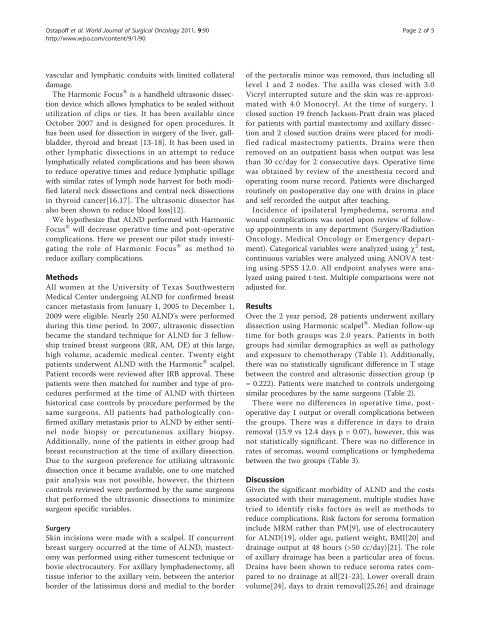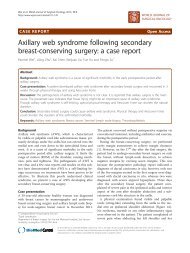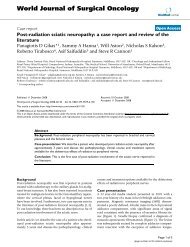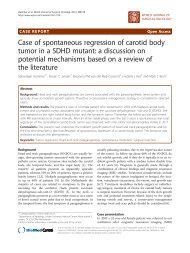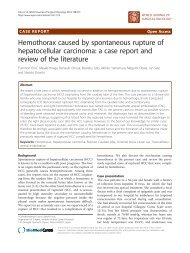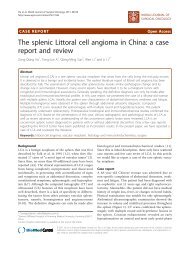Axillary lymph node dissection for breast cancer utilizing Harmonic ...
Axillary lymph node dissection for breast cancer utilizing Harmonic ...
Axillary lymph node dissection for breast cancer utilizing Harmonic ...
Create successful ePaper yourself
Turn your PDF publications into a flip-book with our unique Google optimized e-Paper software.
Ostapoff et al. World Journal of Surgical Oncology 2011, 9:90http://www.wjso.com/content/9/1/90Page 2 of 5vascular and <strong>lymph</strong>atic conduits with limited collateraldamage.The <strong>Harmonic</strong> Focus ® is a handheld ultrasonic <strong>dissection</strong>device which allows <strong>lymph</strong>atics to be sealed withoututilization of clips or ties. It has been available sinceOctober 2007 and is designed <strong>for</strong> open procedures. Ithas been used <strong>for</strong> <strong>dissection</strong> in surgery of the liver, gallbladder,thyroid and <strong>breast</strong> [13-18]. It has been used inother <strong>lymph</strong>atic <strong>dissection</strong>s in an attempt to reduce<strong>lymph</strong>atically related complications and has been shownto reduce operative times and reduce <strong>lymph</strong>atic spillagewith similar rates of <strong>lymph</strong> <strong>node</strong> harvest <strong>for</strong> both modifiedlateral neck <strong>dissection</strong>s and central neck <strong>dissection</strong>sin thyroid <strong>cancer</strong>[16,17]. The ultrasonic dissector hasalso been shown to reduce blood loss[12].We hypothesize that ALND per<strong>for</strong>med with <strong>Harmonic</strong>Focus ® will decrease operative time and post-operativecomplications. Here we present our pilot study investigatingthe role of <strong>Harmonic</strong> Focus ® as method toreduce axillary complications.MethodsAll women at the University of Texas SouthwesternMedical Center undergoing ALND <strong>for</strong> confirmed <strong>breast</strong><strong>cancer</strong> metastasis from January 1, 2005 to December 1,2009 were eligible. Nearly 250 ALND’s were per<strong>for</strong>medduring this time period. In 2007, ultrasonic <strong>dissection</strong>became the standard technique <strong>for</strong> ALND <strong>for</strong> 3 fellowshiptrained <strong>breast</strong> surgeons (RR, AM, DE) at this large,high volume, academic medical center. Twenty eightpatients underwent ALND with the <strong>Harmonic</strong> ® scalpel.Patient records were reviewed after IRB approval. Thesepatients were then matched <strong>for</strong> number and type of proceduresper<strong>for</strong>med at the time of ALND with thirteenhistorical case controls by procedure per<strong>for</strong>med by thesame surgeons. All patients had pathologically confirmedaxillary metastasis prior to ALND by either sentinel<strong>node</strong> biopsy or percutaneous axillary biopsy.Additionally, none of the patients in either group had<strong>breast</strong> reconstruction at the time of axillary <strong>dissection</strong>.Due to the surgeon preference <strong>for</strong> <strong>utilizing</strong> ultrasonic<strong>dissection</strong> once it became available, one to one matchedpair analysis was not possible, however, the thirteencontrols reviewed were per<strong>for</strong>med by the same surgeonsthat per<strong>for</strong>med the ultrasonic <strong>dissection</strong>s to minimizesurgeon specific variables.SurgerySkin incisions were made with a scalpel. If concurrent<strong>breast</strong> surgery occurred at the time of ALND, mastectomywas per<strong>for</strong>med using either tumescent technique orbovie electrocautery. For axillary <strong>lymph</strong>adenectomy, alltissue inferior to the axillary vein, between the anteriorborder of the latissimus dorsi and medial to the borderof the pectoralis minor was removed, thus including alllevel 1 and 2 <strong>node</strong>s. The axilla was closed with 3.0Vicryl interrupted suture and the skin was re-approximatedwith 4.0 Monocryl. At the time of surgery, 1closed suction 19 french Jackson-Pratt drain was placed<strong>for</strong> patients with partial mastectomy and axillary <strong>dissection</strong>and 2 closed suction drains were placed <strong>for</strong> modifiedradical mastectomy patients. Drains were thenremoved on an outpatient basis when output was lessthan 30 cc/day <strong>for</strong> 2 consecutive days. Operative timewas obtained by review of the anesthesia record andoperating room nurse record. Patients were dischargedroutinely on postoperative day one with drains in placeand self recorded the output after teaching.Incidence of ipsilateral <strong>lymph</strong>edema, seroma andwound complications was noted upon review of followupappointments in any department (Surgery/RadiationOncology, Medical Oncology or Emergency department).Categorical variables were analyzed using c 2 test,continuous variables were analyzed using ANOVA testingusing SPSS 12.0. All endpoint analyses were analyzedusing paired t-test. Multiple comparisons were notadjusted <strong>for</strong>.ResultsOver the 2 year period, 28 patients underwent axillary<strong>dissection</strong> using <strong>Harmonic</strong> scalpel ® .Medianfollow-uptime <strong>for</strong> both groups was 2.0 years. Patients in bothgroups had similar demographicsaswellaspathologyand exposure to chemotherapy (Table 1). Additionally,there was no statistically significant difference in T stagebetween the control and ultrasonic <strong>dissection</strong> group (p= 0.222). Patients were matched to controls undergoingsimilar procedures by the same surgeons (Table 2).There were no differences in operative time, postoperativeday 1 output or overall complications betweenthegroups.Therewasadifferenceindaystodrainremoval (15.9 vs 12.4 days p = 0.07), however, this wasnot statistically significant. There was no difference inrates of seromas, wound complications or <strong>lymph</strong>edemabetween the two groups (Table 3).DiscussionGiven the significant morbidity of ALND and the costsassociated with their management, multiple studies havetried to identify risks factors as well as methods toreduce complications. Risk factors <strong>for</strong> seroma <strong>for</strong>mationinclude MRM rather than PM[9], use of electrocautery<strong>for</strong> ALND[19], older age, patient weight, BMI[20] anddrainage output at 48 hours (>50 cc/day)[21]. The roleof axillary drainage has been a particular area of focus.Drains have been shown to reduce seroma rates comparedto no drainage at all[21-23]. Lower overall drainvolume[24], days to drain removal[25,26] and drainage


